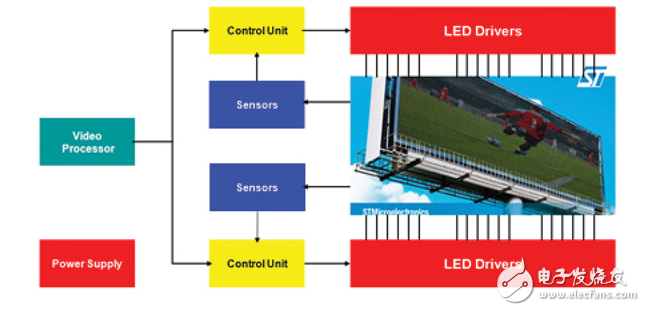
资料下载

LED标牌应用混合颜色、节能和复杂性
LED标牌应用混合颜色、节能和复杂性
标牌是最具挑战性的LED应用之一。它包括一个大而多样化的市场,包括单色信息标志(例如进出口标志)和简单的信息标志;公共汽车和火车站的多色目的地标志;公共汽车和火车内显示。RGB应用程序包括体育场馆的大屏幕和小显示屏,以及使用数千个LED驱动芯片的多媒体广告牌。例如,靠近公路的一个大广告牌大小的标志可以集成125000个或更多的设备。
标志的基本知识
大型LED标志由模块组成,包括LED、驱动器、电源、控制单元、传感器和某种源于LED测序数据的处理器。具有高刷新率的RGB标志显示通常需要每个模块上的MCU来实现色彩校正。对于在现场部署LED标志/显示后,微控制器对于处理突发事件也是非常重要的。随着时间的推移,LED改变颜色,有时会失败。模块也开始失败。MCU存储关于旧模块的操作特性的信息。这允许对新模块进行正确的颜色校准。图1显示了在体育场中可以找到的高端标志显示屏的主要组成部分。

Figure 1: Large signage displays use hundreds of thousands of LED drivers (Courtesy of STMicroelectronics)。
The components of most interest in this article have the following primary characteristics:
The LEDs themselves typically have drive currents in the 8 to 10 mA range. The higher current devices are used for outdoor applications and different colors require different drive currents, which creates a design complication that will be discussed later.
The driver market is probably the most significant and – except for simple signage applications – 16-bit chips tend to predominate. They become progressively more expensive as special features such as error detection, gain control, PWM, the ability to identify LED failure, thermal shutdown and other features are added. Another important reason for 16-bit dominance is that many controllers output data in bytes.
Control units can be purchased but many design teams choose to create their own controller using an FPGA.
声明:本文内容及配图由入驻作者撰写或者入驻合作网站授权转载。文章观点仅代表作者本人,不代表电子发烧友网立场。文章及其配图仅供工程师学习之用,如有内容侵权或者其他违规问题,请联系本站处理。 举报投诉
- 相关下载
- 相关文章





